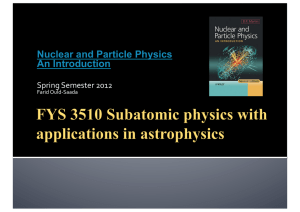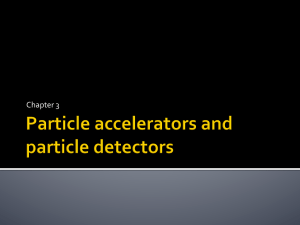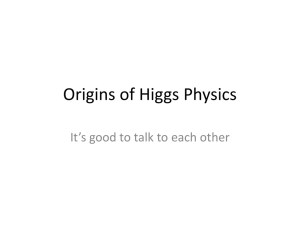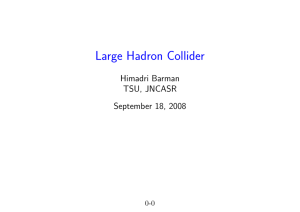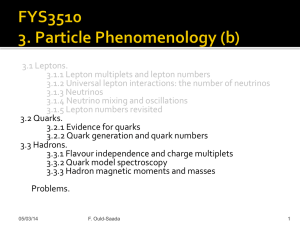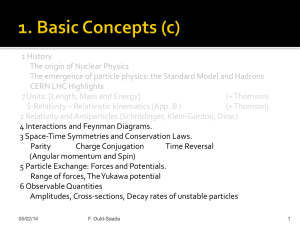Document 11541191
advertisement
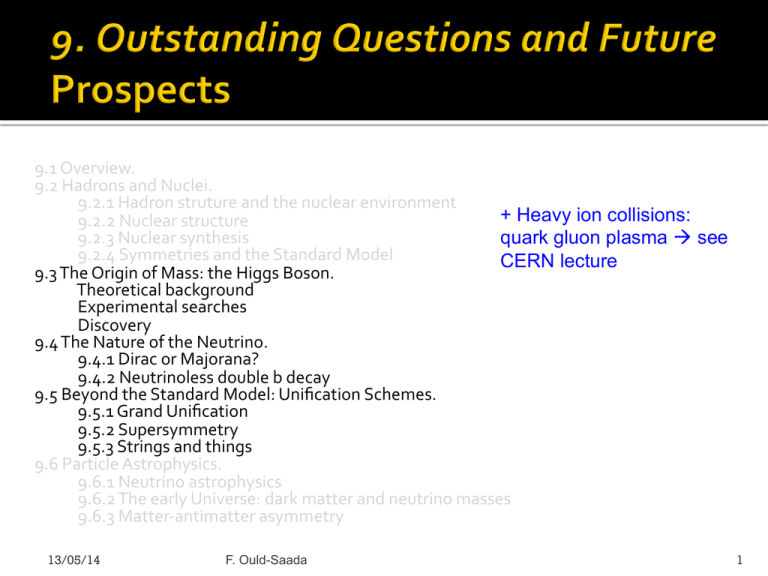
9.1 Overview. 9.2 Hadrons and Nuclei. 9.2.1 Hadron struture and the nuclear environment + Heavy ion collisions: 9.2.2 Nuclear structure 9.2.3 Nuclear synthesis quark gluon plasma à see 9.2.4 Symmetries and the Standard Model CERN lecture 9.3 The Origin of Mass: the Higgs Boson. Theoretical background Experimental searches Discovery 9.4 The Nature of the Neutrino. 9.4.1 Dirac or Majorana? 9.4.2 Neutrinoless double b decay 9.5 Beyond the Standard Model: Unification Schemes. 9.5.1 Grand Unification 9.5.2 Supersymmetry 9.5.3 Strings and things 9.6 Particle Astrophysics. 9.6.1 Neutrino astrophysics 9.6.2 The early Universe: dark matter and neutrino masses 9.6.3 Matter-­‐antimatter asymmetry 13/05/14 F. Ould-Saada 1 SU (3)C × SU (2) L ×U (1)Y 1. Spin-­‐1-­‐gauge boson sector • SU(3)C represents QCD – The gauge bosons – 8 mass-­‐less colored gluons – couple only to color-­‐charged particles, quarks & gluons • SU(2)LxU(1)Y represents EW interaction – L indicates that SU(2) couples only to left-­‐handed particles, fermions = quarks and leptons – Y indicates that U(1) couples to weak hypercharge – After SSB à • 3 massive gauge bosons of WI, W+, W-­‐, Z0 • 1 mass-­‐less gauge boson of EM, γ 13/05/14 F. Ould-Saada 2. Spin-­‐1/2-­‐fermions come in 3 families or generations – 5 multiplets per family, according to how they transform under gauge symmetries • Particles within each multiplet are transformed into each other by gauge symmetries • Particles in different multiplets are not – Hypercharge assignments look rather ad-­‐hoc à beyond SM? – In total 15 particles à 45 for 3 families! 2 SU (3)C × SU (2) L ×U (1)Y Q = I3 + Y 2 € 3. Spin-­‐0-­‐Higgs sector • EW SSB • How many Higgs bosons? 13/05/14 F. Ould-Saada 3 ¡ One of main challenges in particle physics § Understand EW symmetry breaking and origin of mass § Solution? Existence of Scalar Higgs boson ¡ ¡ ¡ Motivations for Higgs Experimental search Discovery 13/05/14 F. Ould-Saada 4 The Standard Theory of Particles and Forces § Forces are dictated by (gauge) symmetries ú Fermions in 3! = SU(3)C*[SU(2)L*U(1)Y] à QCD + Electroweak (“=“ QED + Weak) § Symmetries of laws do not necessarily lead to symmetries of outcomes ú Electroweak symmetry spontaneously broken – Brout Englert Higgs mechanism ú BEH “hides” EW symmetry, gives masses to weak gauge bosons and “approves” fermion masses, predicts couplings of particles to Higgs, and more § Higgs boson mass is not predicted by the SM § è Must be measured! Physics with ATLAS 13/05/14 5 ¡ Higgs coupling to massive particles predicted § H couples very weakly to light particles, like e, µ, ν, u,d,s § H couples more strongly to W,Z,t,b § Coupling to fermions ~ mf § Coupling to bosons ~ mV2 13/05/14 F. Ould-Saada 6 g Hff M H < 2MW : ⎛ m f = 2 gW ⎜⎜ ⎝ MW ⎞ ⎟⎟ ⎠ H → bb → 2 − jet 2 M ) =Ο (10− 4 M ) Γ ( H →bb ) =Ο ( g Hff H H M H ≥ 2 M W : H → W +W − M H ≥ 2M Z : H → Z 0Z 0 M H ≥ 2M t : H → tt 13/05/14 F. Ould-Saada 7 ¡ ¡ Rare Higgs decay modes − H → γγ BR ≈ 10 −3 −H →Z 0 ff M H :110−150GeV / c2 Total width depends strongly on Higgs mass § Note increase due to gauge boson channel opening § Width ~mass at TeV! 13/05/14 F. Ould-Saada 8 ¡ ¡ Higgs boson has rich spectrum of decay modes Branching ratios depend strongly on Higgs mass 13/05/14 F. Ould-Saada 9 s ≤ 208 GeV e + e − → H 0 Z 0 H → bb ⇒ M H > 114GeV / c 2 13/05/14 F. Ould-Saada 10 −M H < 2MW H →bb ,τ +τ − −M H ≥ 2MW H →W +W − →l + l −ν lν l −M H ≥ 2M Z H →Z 0 Z 0 →l + l − l + l − ATLAS, CMS optimized to search up to 1 TeV masses 13/05/14 F. Ould-Saada 12 ¡ ¡ ¡ 13/05/14 Higgs and more - F. Ould-Saada 125 GeV … a rather good compromise 4/5 production processes ≥5 decay channels 13 Hàγγ 14 HàZZ*àl+l-­‐l+l-­‐ § Understanding of “background” is important ú Most of which is due to important physics at the Higgs and more - F. Ould-Saada heart of the gauge structure / symmetry of electroweak interaction ú Higgs showed up between 2 relatively busy regions! 13/05/14 15 ¡ SM successful in describing nearly all existing experimental data § à various attempts to extend ElectroWeak unification to include QCD à Grand Unification (GUT)? Lepton-­‐Quark Symmetry § à including Gravity in larger unification schemes? ¡ ¡ ¡ Grand Unification Supersymmetry Superstrings 13/05/14 F. Ould-Saada 16 ¡ Although agreement between SM and experiments is not far from being perfect § SM contains many parameters to be determined experimentally ▪ Coupling constants, mixing angles, particle masses (fermions, gauge bosons, Higgs boson), … § Many of such parameters have nothing to do with the symmetries of the theory § SM leaves several questions unanswered ▪ ▪ ▪ ▪ ▪ Why are there exactly 3 independent symmetry groups? What about reducing the number of free parameters? Why are there 3 families of quarks and leptons? What is the origin of the symmetry between quarks and leptons? Are fermions composite objects? ¡ Why is electric charge quantized and proton and electron have exactly opposite charge? § Why are quark charges fractional? ¡ ¡ What is the solution to the hierarchy problem, that the EW scale is so small compared to the Planck scale? § MW~10-­‐17 MPl? What is the solution to the fine tuning problem? § Loop corrections involving Higgs are quadratically divergent, such that corrections to Higgs mass are many orders of magnitude larger than the mass itself! § Unnatural fine tuning is needed, which consists in adjusting counter terms order by order in perturbation theory to cancel the divergences ¡ ¡ ¡ ¡ 17th century, Newton realized 1st unification between falling bodies and planet movements 19th century, Maxwell, in his EM theory of light, unified electricity and magnetism, on one hand, and optics on the other hand 20th century, GSW described weak force in the same formalism as EM § One parameter, θW, relates the 2 coupling constants Towards Grand unification also including strong force? § With Supersymmetry? ¡ Or? § Gravity+GUT+SUSY=SuperStrings? ¡ Let us hope that time scale unit won’t be 100 years! ¡ ¡ ¡ Current data hint at a unification between Strong and Electroweak forces ... at much larger energies, GUT scale. GUT is a symmetry between Leptons and Quarks § unifies strong and electroweak forces § Requires new gauge bosons and baryon number violation SUSY unifies “matter and force particles”: “matter-­‐force duality” § relates particles of different spins: Fermions-­‐Bosons § introduces super-­‐partners to each SM particle § requires 5 Higgs particles § provides DM candidate 13/05/14 F. Ould-­‐Saada: HEPP & ATLAS GUT ...SUSY... 20 GU ⊃ SU (3)C ⊗ SU (2) L ⊗ U (1)Y ! % "$" # %""$""# GUT ¡ ¡ QCD EW EWT+QCD à grand unified theories – GUTs gU at MX~1015 GeV ¡ 13/05/14 Given the measurement uncertainties Supersymmetry needed to achieve unification at MX~1016 GeV F. Ould-Saada 21 Strong Weak Electromagnetic 13/05/14 F. Ould-Saada: HEPP & ATLAS 22 (d r ,d b ,d g ,e + ,νe ) § Quarks and leptons in multiplets (d r ,d b ,d g ,e + ,νe ) § New interactions mediated by new gauge bosons X and Y Q(X) = −4 / 3; Q(Y) = −1/ 3 gU2 1 αU ≡ ≈ 4π 42 § Within the multiplet § à explanation of why proton 3qd + e = 0 ⇒ q p = 2qu + qd = e and positron have exactly same charge 13/05/14 F. Ould-Saada 23 dRred dRgreen dRblue e R+ νe~ dRred g,γ,Z gr+g gr+b X-4/3red Y-1/3red dRgreen gg+r g,γ,Z gg+b X-4/3green Y-1/3green dRblue gb+r gb+g g,γ,Z X-4/3blue Y-1/3blue e R+ X4/3red X4/3green X4/3blue γ,Z W+ νe~ Y1/3red Y1/3green Y1/3blue W- Z SU(5) multiplets (d r ,d b ,d g ,e + ,νe ) ¡ Testing GUTs § Low energy coupling expressible from αU and MX § à prediction of weak mixing angle ¡ sin 2 θW = 0.214 ± 0.004 sin 2 θW (meas.) = 0.2313 ± 0.0003 Testing GUTs § X,Y vertices § à reactions where L and B violated § à proton unstable! 13/05/14 F. Ould-Saada 25 § à proton unstable! _ p → π 0 + e+ p → π + +νe R ≡ B − ∑ Ll conserved! l (M X c 2 )4 τp ≈ 4 gU (M p c 2 )5 τ p ≈ 1030±1 yr § Limits obtained by Kamiokande rule out simplest versions of GUTs à Incorporation of SUSY 13/05/14 F. Ould-Saada 26 Proton decay: p ! e+ π˚ Ø To achieve lifetime limits of 1033-1034 Ø need to control 1034 protons ... Ø Super Kamiokande: Water Cerenkov technique - 50 000 t of pure water (22 500 t fiducial volume) - readout by ½- m photomultipliers, 1000 m underground N p = M(kg)(10 3 kg /g) N A ( ) = 2.25 × 10 10 18 7 × 10 3 × 6 × 10 23 ( ) = 7.5 × 10 10 18 33 Ø After 7 years, exposure= MΔt=138 000 t yr à NpΔt=45 X 1033 Ø Super Kamiokande: Water Cerenkov technique π 0 → γγ M (γγ ) = M π 0 p → e +π 0 M ( e +π 0 ) = M p Ø Detection efficiency: not all protons detected Ø efficiency ~40% τ ≥ B( p → e+π 0 ) × 8.4 ×1033 yr 13/05/14 27 ¡ Introduction of new particles – sparticles -­‐ ensures cancellation in higher order diagrams R-parity = (-1)2s+3B+L R=+1 for particles and -1 for s-particles ¡ ¡ If exact symmetry à particles and sparticles would have same masses SUSY must be broken! 13/05/14 F. Ould-Saada 28 SUSY (WIKIpedia) SUSY Spectrum Supersymmetry facing experiment: much ado (already) about nothing (yet) Weak Scale Supersymmetry ¡ In e+e-­‐ e + e − → e~ + e~ − ⎫ + − + − ~ 0 χ~ 0 e e → e e + χ ± ± 0 ⎬ ~ #"! $ ~ e → e + χ ⎭ missing E/ p e+ e− → χ~0 χ~0 e+ e− → χ~ + χ~ − 13/05/14 F. Ould-Saada 30 ¡ How to incorporate Gravity? § No successful stand-­‐alone quantum theory of Gravity ¡ ¡ Replace point-­‐like particles by 1-­‐dimentional quantum strings formulated in 10 or 11 space-­‐time dimensions Superstring theories have 1 parameter – string tension § However, we leave in 4 dimensions § All extra dimensions have to be compactified § Too many theories, no predictive power ... yet ¡ Higher dimensional branes in 11 dimensions § M-­‐theories à unification of all 5 Superstring theories ¡ Operate at Planck mass-­‐scale § Gravity ~ EW ~ QCD MP = 13/05/14 F. Ould-Saada !c = 1.2 × 1019 GeV / c 2 G 31 Strength EM gravity r ¡ Neutrinos § Elusive particles only feeling weak interactions § Postulated by Pauli in 1930, discovered ~25 years later § Non-­‐zero mass established 50 years later! § What is the nature of the neutrino? ¡ Dirac or Majorana? § original formulation of SM: mν=0 Dirac ⇒ ν ≠ ν ⇒ 4 states L = 1: ν L,ν R L = −1:ν L,ν R Majorana ⇒ ν = ν ⇒ 2states ν L ,ν R § à no distinction between Dirac and Majorana € § Mν # 0 à coupling to νR with relative § mν c 2 2 couplings ( ) E Majorana à lepton number violated 13/05/14 F. Ould-Saada 33 ββ − 2ν : ( Z , A) → ( Z + 2, A) + 2e− + 2νe ββ − 0ν : ( Z , A) → ( Z + 2, A) + 2e− ▪ Only Majorana! ¡ Double β decay is 2nd order in WI § In practice only observable if 1st order forbidden § Even-­‐Z, even-­‐N à even-­‐even nucleus (Z+2,A) ¡ Single β decay à odd-­‐odd nucleus (Z+1,A) § Odd-­‐odd nuclei less stable than even-­‐even nuclei (pairing term in semi-­‐empirical mass formula) § à possible sequence of states where single decay forbidden by energy conservation whereas double decay allowed. § If parent nucleus stable against α and γ decay àlifetimes for double β decay: 1018-­‐1024 yr 48 13/05/14 100 116 128 130 150 238 Ca, 76GeF.,96 Zr , Mo , Cd , Te , Te , Nd , U Ould-Saada 34 ¡ See-­‐saw mechanism § No theoretical understanding of lepton and quark mass pattern § Neutrino masses from oscillations much lower than those of charged leptons § Possible explanation in context of GUTs where both types of neutrinos – Majorana and Dirac – could co-­‐exist § Mass matrix " 0 M =$ # mD mD % ' mM & mD ≈ M EW ; mM ≈ MGUT mM >> mD ⇒ λ+ ≈ mM , !#"# $ very heavy neutrino mD2 λ− ≈ mM !#"# $ observed neutrinos~1eV See-­‐Saw mechanism: one mass goes up the other down! 13/05/14 F. Ould-Saada 35 ¡ ¡ No sign of antimatter in Universe … Simple Big Bang (fails!) § Total baryon number B = 0 § Period when kT>> Ehadronsà equilibrium with photons p + p ↔ γ +γ kT < 2m p ⇒ γ + γ → / p+ p § With expansion annihilation increasingly unlikely § At critical temperature, ratios freeze € NB NB kT ≈ 20MeV ⇒ = ≈ 10 −18 ; Nγ Nγ € § BUT actual observed € 13/05/14 € NB NB −9 ≈ 10 ; ≈ 10 −13 ; Nγ Nγ F. Ould-Saada p+ p → / γ +γ NB =1 NB NB ≈ 10 −4 NB 36 ¡ Sakharov: necessary to have § (a) an interaction that violates baryon number § (b) an interaction that violates charge conjugation C and CP § (c) a non-­‐equilibrium situation to seed the process ¡ Current situation § CP violation observed in K and B decays not enough § Unknown sources of CP violations? Such in SUSY theories § Generation of non-­‐equilibrium? Maybe be within Baryon-­‐violating interactions of GUTs ¡ Matter-­‐Antimatter asymmetry remains a serious unsolved problem … kT > M X ⇒ X + X ↔ matter + radiation kT << M X ⇒ no profuction norannihilation of X + X ⇒ X + X CP − violating decays ⇒ more matter than antimatter 13/05/14 F. Ould-Saada 37 ¡ Matter-­‐Antimatter asymmetry remains a serious unsolved problem … ¡ … as are several other problems … ¡ … waiting for you … 13/05/14 F. Ould-Saada 38

